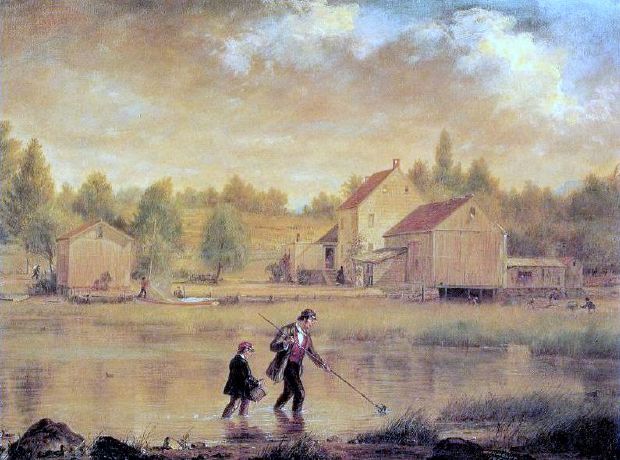
Productivity, diversity, and worth of Coastal elements
![]()
The Isles of Enchantment; Islas des Incantadas.
features | risks | values | protective dunes | metaphor | landscapes
Island's landscape features define the carrying capacity of the terrain.
Social | Physical | Biological | Ecological
Every environmental problem has three broad facets to describe in solving the conflicts:
| habitat | |||
| culture | = |
Ecological | |
| biotic community | |||
Area is called Habitat | the inorganic conditions of any place
Biocenose is called the biotic community | all living things
Culture is all of the past impacts on the terrain | landscape
The ABCs of ecological design begin with demonstrating how these components fit together like parts of a stereo:
habitat is the receiver
the biotic community is the amplifier
the sound you hear is the culture or social values
features | risks | values | protective dunes | metaphor | landscapes
Oak Savanna woodland of trees and mixed grasses.
Thus, ecology is the information conveyed from all of the parts of a landscape linked and functioning together to convert electromagnetic energy into --by analogy-- the music and sound of a terrain, or the characteristics of any place.
The values associated with ecological features of any place are fundamental in that they are primary to defining what exists, how that existence functions and when food is available for those creatures that consume the biological wealth found in any terrain or area of the seas.
Ecological accounting informs design: This is the most important concept with respect to measuring the comparative values of any development or restoration of landscape:
- the concept forms the basis -- or baseline-- for measurement
- the measure involves energy (sunlight or radiation), water and waste.
- the accounting is based, in part, on net primary productivity
- the accounting is based, in part, on ecosystem services
- the accounting is comparative
- current costs when compared to operations and maintenance costs
- initial outlay versus the long term, or life-cycle costs
- currency or capital consumed or gained versus energy expended or captured.
features | risks | values | protective dunes | metaphor | landscapes
Social
conditions may reveal pervasive values.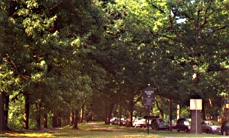
The human or animal crafted conditions of existence in any place are called a cultural landscape.
The photograph on the right is a portion of the "green necklace" designed in the 1890s by landscape architect Frederick Law Olmsted Sr. separating Brookline from Jamaica Plain in Boston. Olmsted's concept was to use natural features of rivers and marshes, old glacial pools and forests collectively called the fenway to augment or add to his idea of a park that surround and delineate different suburbs of Boston from one another. Today, a thin island, or buffer of forests, marshes and glens persist among the urban density of southwestern Boston, because of the vision and the continued support of the Boston Parks Department.
One may see by this that landscape modification, for what ever purpose: commercial, residential, municipal, or recreational, are manifestants of values inherent in the use, reuse, or creation of landscape features.
Density and propensity for harm from flooding, a high risk map.
The darker the shade of blue, the more people per square mile residing in that place.
Landscape features
Spring bloom in the chaparral, Santa Barbara, California: 1870s.
Any landscape feature includes the distinguishing structures on, conditions of, indications of habitation on, or aspects of an area with information about a terrain. These features may be natural or crafted by people or animals; domesticated or wild creatures all may influence the look, smell, shape, size or persistence of landscape features.
The terrain may be submerged (called the benthic zone) or exposed as dry, moist or seasonally wet, land. Each of these areas are characterized by a particular association of plants, fungus and bacteria. These creatures transform the soil from an inorganic setting into a thriving community of organisms that attract, fish, reptiles, amphibians, birds, mammals and other creatures that are affected by inhabitants of a place.
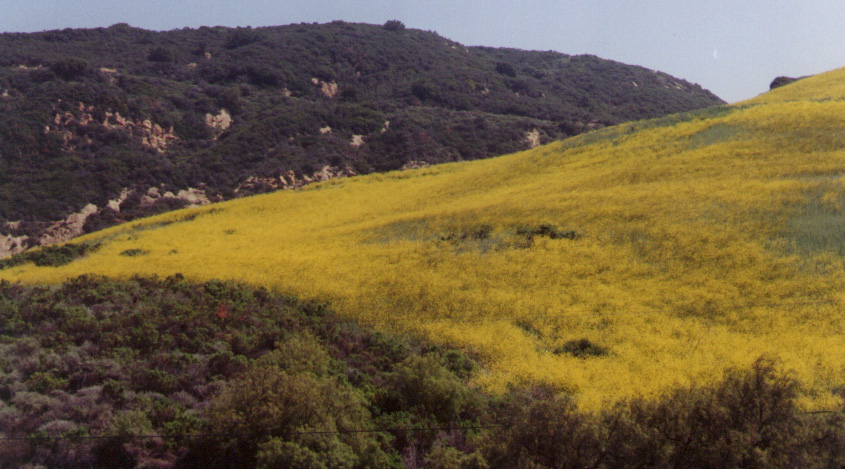
Monterey shale formation in the foreground looking from east to west , along the Santa Barbara Channel.
Computer imagery of topographical relief, looking from west to east, along the Santa Barbara Channel.
Human habitation may either expand or reduce the ranges of particular fish, reptiles, amphibians, birds, mammals and other creatures depending on the sort of culture and society dominant in the area. Dominant patterns of extracting a living from the land, such as mining, fishing, forestry, hunting, agriculture, or manufacturing have an impact on the quality of the vegetation and animals that comprise any terrain.
features | risks | values | protective dunes | metaphor | landscapes
The inorganic conditions of existence: radiation, water, wind and minerals.
 Water molecules.
Water molecules.
These features indicate limitations imposed by geology, geography, radiation, chemistry and physical forces that shape the setting or situation of a place.
Elevation and relief are of utmost importance on coastal islands.
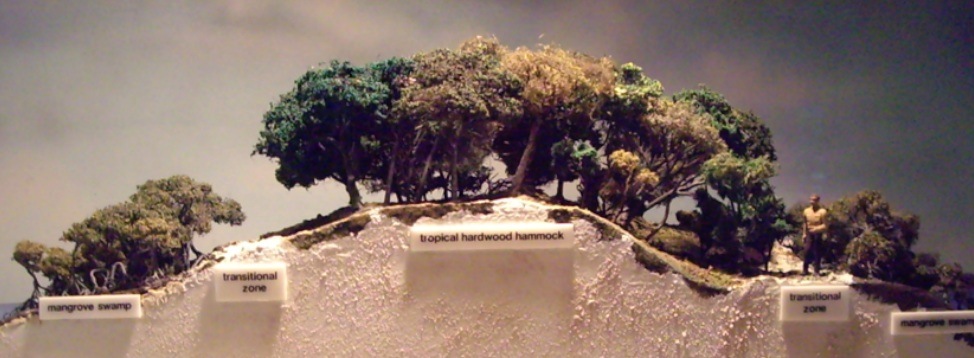
25 feet: Back dune
10 feet: Fore dune
Sea Level
submarine 10 feet: offshore bar
submarine 25 feet: near trough
submarine 50 feet: shore face
The beach, any beach, is a creature of the sea's extreme fury and moderate daily motion. Many beaches are often modified by vegetation where, above the tide line, seeds may take root and send out rhizomes to hold the soil against wind, water and tidal surges that all cause erosion. Dunes are the initial line of physical defense on land against an advancing sea. Without a dune system the islands of the shoreline are more vulnerable to overwash, or the force of water --from either a high tide in the bay, or a storm surge from the sea-- to breach the island, thereby washing away a dune system.
Overwash fans are remnants of a dune system flooded by and removed by the action of the ocean.
The pollution of water that directly kills or indirectly leads to dead zones can create conditions that trigger hazardous algal blooms. Estuaries in the United States are so contaminated by storm water runoff, pesticides, herbicides, oil-based car exhausts and fertilizers that the acidity of the water is changing and outbreaks of harmful algae populations endanger the health of humans and fisheries alike.
Hazardous Algal Bloom, or HAB sites in US and globally where human impact damages the seashore.
Any dune system is the land's defensive line against rising seas.
Transect revealing natural features & separate zones of a barrier island.
 Tidelands are owned by the public.
Tidelands are owned by the public.
![]()
Aerial view of the features of an island in relation to their risk of exposure to flooding:
Much of the Island must remain in natural conditions for the security of all the inhabitants, humans, either residents or commercial property owners, and wildlife alike. Back dune areas such as this on Cape Hatteras are necessary for rain water to percolate down into underground storage in rock layers called aquifers.
Biological features , or natural capital referred to as biotic wealth
The organic conditions of existence are tied fundamentally to the producing organisms and the varieties of creatures living in any place. Productivity and diversity are two distinct characteristics of any biotic community.
| classification | Function | Form |
| measure | Productivity | Diversity |
terms: |
habitat varieties |
|
-
(minus) Respiration |
genetic
variability |
|
=
Net primary Productivity |
Species
richness |
|
qualities: |
Process,
or functional quality |
Form,
or formal quality |
Preserving areas in Philadelphia as examples of restraints on development.
Biomass, or the total amount of living material in a place depends on the process of productivity.
Productivity is usually the sum of the food, fuel, forage or fodder made available by the combined contributions of microorganisms, fungus, and plants that convert inorganic material, water and energy into living tissues. These creatures may feed on sulfur, nitrogen or sunlight converting inorganic minerals into organic material.
| Animals can, in mutualistic or symbiotic situations, be the productive facet of any place's many features, but the most evident producing facet of places along the shore or on land is the vegetation. | ||
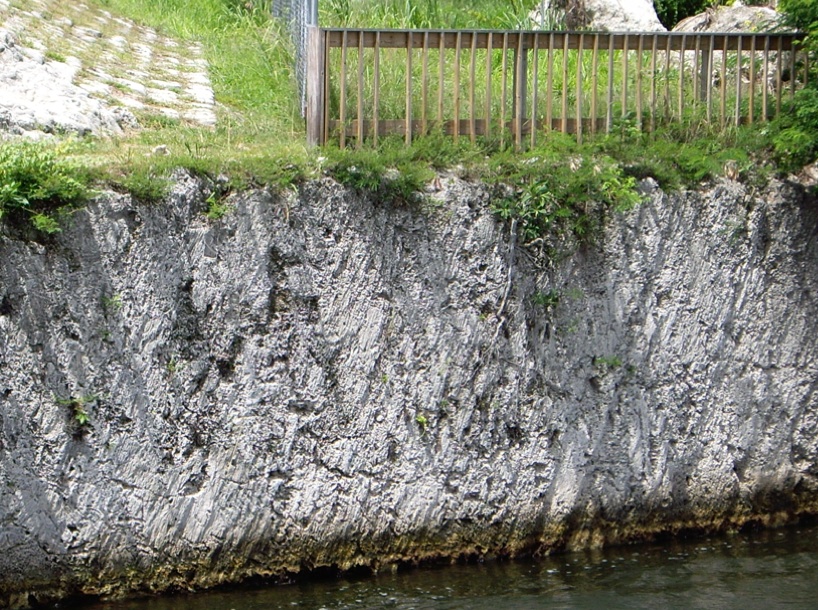 |
||
Examples of symbiotic animals (polyps and algae) that contribute to the productivity in the near-shore zone of the sea is --of course-- the coral reefs. Corals are comprised of thousands of colonial animals of numerous species that live adjacent to one another sustaining fish, protecting shorelines, and altering the very shape of the habitat over time. Coral reefs are the producers of the tropical shores, builders of landscape under the sea and the sustaining feature of people and animals of the islands or places where these symbiotic and diverse reefs thrive. |
||
| The substrate of Key Largo is a limestone wall: the fossil remains of a 12,000 year old coral barrier reef in the Upper Florida Keys. | ||
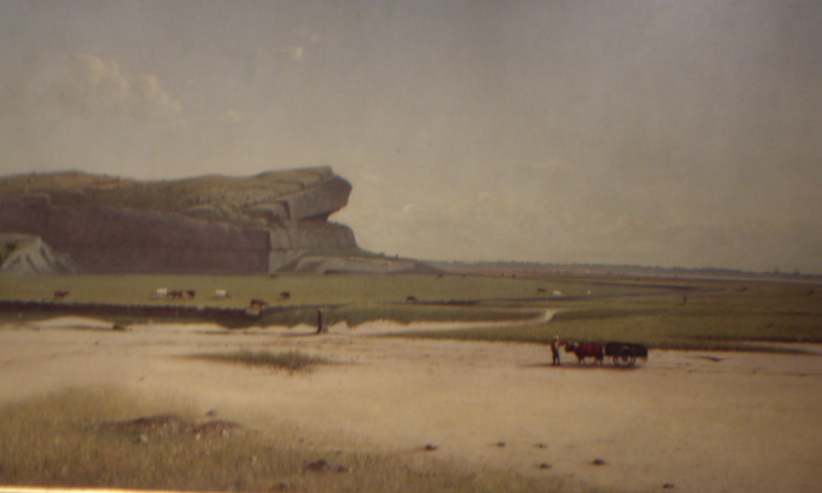
Marshes of Newport, Rhode Island, 1860.